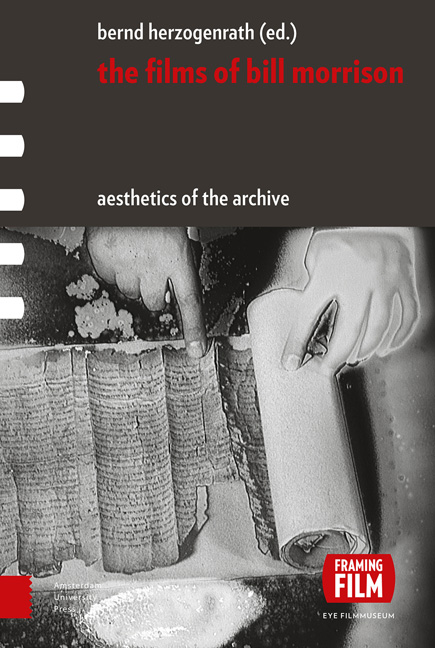Book contents
- Frontmatter
- Contents
- Acknowledgments
- Aesthetics of the Archive: An Introduction
- Chapter 1 Drafts and Fragments: Reflections around Bill Morrison and the Paper Print Collection
- Chapter 2 The Film of Her: The Cine-Poet Laureate of Orphan Films
- Chapter 3 Ghost Trip: Searching for Potential Myths
- Chapter 4 Decasia: The Matter | Image: Film is also a Thing
- Chapter 5 The Mesmerist: Illustrating the Return of the Repressed
- Chapter 6 Light is Calling: Celluloid Dreams
- Chapter 7 Gotham: Zoetrope: Block by Block
- Chapter 8 Outerborough: Early Cinema Revisited
- Chapter 9 The Highwater Trilogy: Thinking the Liquid – On the Ethics of Water and the Material Ecologies of Disaster and Ruination
- Chapter 10 Porch: Archives, Collective Memory, and the Poetics of Home Movies
- Chapter 11 The Future Lasts Long: The Romanov Lost Family Archives
- Chapter 12 Who by Water: Variations on Matter, Figures, Memory, and Mythology
- Chapter 13 Every Stop on the F-Train: Beyond and within the Restless Netherworld of (Manhattan’s) Mind
- Chapter 14 Spark of Being: Bachelor Machine
- Chapter 15 The Miners’ Hymns: Acts of Resurrection
- Chapter 16 Tributes – Pulse: A Requiem for the 20th Century: Death | Drive | Image
- Chapter 17 Just Ancient Loops: The Loops of Life in Intonation
- Chapter 18 The Great Flood: Water is Transparence Derived from the Presence of Everything
- Chapter 19 Re-Awakenings: Bill Morrison in Conversation
- Index of Film Titles
- Index of Names
- Index of Subjects
- Already Published
Chapter 16 - Tributes – Pulse: A Requiem for the 20th Century: Death | Drive | Image
Published online by Cambridge University Press: 12 December 2020
- Frontmatter
- Contents
- Acknowledgments
- Aesthetics of the Archive: An Introduction
- Chapter 1 Drafts and Fragments: Reflections around Bill Morrison and the Paper Print Collection
- Chapter 2 The Film of Her: The Cine-Poet Laureate of Orphan Films
- Chapter 3 Ghost Trip: Searching for Potential Myths
- Chapter 4 Decasia: The Matter | Image: Film is also a Thing
- Chapter 5 The Mesmerist: Illustrating the Return of the Repressed
- Chapter 6 Light is Calling: Celluloid Dreams
- Chapter 7 Gotham: Zoetrope: Block by Block
- Chapter 8 Outerborough: Early Cinema Revisited
- Chapter 9 The Highwater Trilogy: Thinking the Liquid – On the Ethics of Water and the Material Ecologies of Disaster and Ruination
- Chapter 10 Porch: Archives, Collective Memory, and the Poetics of Home Movies
- Chapter 11 The Future Lasts Long: The Romanov Lost Family Archives
- Chapter 12 Who by Water: Variations on Matter, Figures, Memory, and Mythology
- Chapter 13 Every Stop on the F-Train: Beyond and within the Restless Netherworld of (Manhattan’s) Mind
- Chapter 14 Spark of Being: Bachelor Machine
- Chapter 15 The Miners’ Hymns: Acts of Resurrection
- Chapter 16 Tributes – Pulse: A Requiem for the 20th Century: Death | Drive | Image
- Chapter 17 Just Ancient Loops: The Loops of Life in Intonation
- Chapter 18 The Great Flood: Water is Transparence Derived from the Presence of Everything
- Chapter 19 Re-Awakenings: Bill Morrison in Conversation
- Index of Film Titles
- Index of Names
- Index of Subjects
- Already Published
Summary
ABSTRACT
Picking up on the concept of death-drive, as discussed by Freud and Lacan, this essay examines the ways in which the film Tributes–Pulse: A Requiem for the 20th Century uses decomposing film material, not as a final state, but rather as a new beginning for cinema. Similar to the death-drive's capacity to transcend the common dichotomy of life and death, Morrison's film keeps the disintegrating images alive in their process of dying. Dying proves to be the very opposite of death: not some ultimate break but an active process, which can be prolonged, paused, and extended into eternity. The title's ‘pulse’ can be understood, as the irresistible, undead beat of the drive itself, which has no other goal than its own circular movement.
KEYWORDS
circularity, death, drive, pulsar
The image does not, at first glance, resemble the corpse, but the cadaver's strangeness is perhaps also that of the image.
– Maurice Blanchot (1982, 256)What we see, we cannot tell. These bubbling, crumbling, dying images leave us speechless, breathless, and devastated. Is this how it all ends, or how it starts? Or is it both?
The images with which Bill Morrison opens his film Tributes–Pulse: A Requiem for the 20th Century are in such an extreme state of decay that it is impossible to tell what they once featured. The decomposing nitrate film stock shows nothing more than pure visual noise – a degree zero of cinema – or even less than that. Thus, the unprepared viewer may wonder if this constantly changing, flickering chaos of dots and lines, covering almost the entire frame, is really cinematographic after all, or if it is only graphic. Indeed, the opening shots look more like pencil drawings or minute etchings, depicting some mysterious fungi, like the one covering those last rocks visited by the time traveller in H.G.Wells’ The Time Machine on his journey to end of the world. Pre-filmic in its appearance, anything could be hidden in this incomprehensible, primordial mess. And there are things hiding: since it is from this very chaos of flickering black and white that Morrison allows all the other scenes of his film emerge, eventually also his own original material, with which the film concludes.
- Type
- Chapter
- Information
- The Films of Bill MorrisonAesthetics of the Archive, pp. 241 - 252Publisher: Amsterdam University PressPrint publication year: 2017



